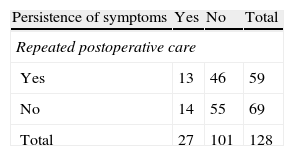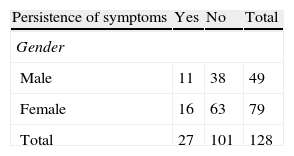Epiphora caused by nasolacrimal drainage system obstruction is the main indication for dacryocystorhinostomy (DCR). So are chronic conjunctivitis and dacryocystitis from the same origin. Nasal endoscopy and the introduction of laser assisted DCR have facilitated the performance of the technique. However, it requires complex and expensive equipment, so there are still supporters of the traditional external procedure.
The aim of this work was to study the effectiveness and usefulness of local postoperative care in laser DCR final result.
Material and methodsWe studied a group of 96 patients diagnosed with epiphora secondary to stenosis-occlusion of the nasolacrimal duct. Of these, 32 patients underwent surgery in both eyes, making a total of 128 cases. The surgery was performed in a private setting between January 1999 and December 2008. The 128 cases were divided into 2 groups: 59 cases in which between 4 and 6 postoperative cures were given in the 2 months following the surgery, and another group of 69 cases in which a single cure was given approximately 7 days after surgery. The final assessment of the outcome of the intervention was done in all cases between 24 and 30 months after surgery.
ResultsIn 27 cases out of 128 (79% success), there was a restenosis of tear drainage. No statistically significant differences were found between the 2 groups.
ConclusionsIn the sample of patients who were intervened using laser assisted DCR, implementation of postoperative cure was irrelevant in the success of the intervention.
La epífora originada por la oclusión del drenaje nasolagrimal es la principal indicación de la dacriocistorrinostomía (DCR). Igualmente, lo son la conjuntivitis crónica y la dacriocistitis del mismo origen. La vía endoscópica nasal, y la introducción del láser (DCR láser) ha facilitado la realización de la técnica, aunque requiere un equipamiento complejo y costoso, por lo que siguen existiendo partidarios del procedimiento externo tradicional.
El objetivo de este estudio es analizar la efectividad y utilidad de las curas posoperatorias de la DCR láser en el resultado final.
Material y métodosEstudiamos un grupo de 96 pacientes diagnosticados de epífora secundaria a estenosis-oclusión del conducto nasolagrimal. En 32 pacientes se realizó la intervención en ambos ojos, lo que hace un total de 128 casos. La cirugía se practicó en un ámbito privado entre enero de 1999 y diciembre de 2008. Los 128 casos se dividieron en 2 grupos: 59 casos en los que se realizaron entre 4 y 6 curas posoperatorias en los 2 meses siguientes a la cirugía. Otro grupo de 69 casos en los que se hizo una sola cura, aproximadamente a los 7 días de la intervención. La valoración definitiva del resultado de la intervención se hizo en todos los casos entre 24 y 30 meses tras la cirugía.
ResultadosEn 27 casos de los 128 (79% de éxitos) se produjo una reestenosis del drenaje lagrimal, sin encontrar diferencias estadísticamente significativas entre los 2 grupos.
ConclusionesEn la muestra de pacientes que hemos intervenido mediante DCR láser, resulta irrelevante, en cuanto al éxito de la intervención, la realización o no de curas posoperatorias.







